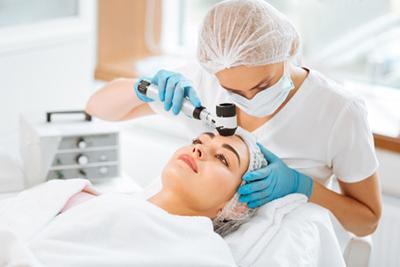
The most prevalent type of cancer to affect adults in the U.S. is skin cancer. Being able to identify the early signs of this disease helps lead to early diagnosis when cancer is easier to treat. The experienced providers at Trident Dermatology in Charleston, SC, screen for skin cancer and can help you learn how to spot the early warning signs.
Types of Skin Cancer
There is more than one type of skin cancer. Basal cell carcinoma and squamous cell carcinoma are two of the most common types and are extremely treatable, particularly when diagnosed early. The most serious form of skin cancer is melanoma, which can be deadly if not caught early. One of the reasons it is so serious is because it is more likely to spread. The good news is that melanoma is the least common type of skin cancer.
Many forms of skin cancer are caused by extensive exposure to ultraviolet (UV) rays from the sun or artificial sources, such as tanning beds. Some steps that can be taken to protect the skin and prevent skin cancer include limiting UV exposure, applying broad-spectrum sunscreen to the skin, and wearing protective gear outdoors, such as long sleeves, pants, sunglasses, and a wide-brimmed hat.
Early Signs of Skin Cancer
Recognizing the early warning signs of skin cancer helps lead to early diagnosis. Most types of skin cancer, including melanoma, are highly treatable and curable when caught early.
Unusual or sudden changes to the skin, such as the growth of a new mole, could be an indication that cancer has developed. Some early signs that skin cancer might be present include:
- The development of sores or bumps that do not heal or go away
- Unusual new growths on the skin that bleed, are painful or change in size
- Pale or waxy patches on the skin that become crusty, scaly, or begin oozing
When examining your skin for possible signs of skin cancer it is important to check any moles you might have. Moles that have developed cancer tend to be asymmetrical, have a jagged or poorly defined border, contain several colors rather than being a consistent shade throughout, and have a diameter bigger than 6mm, which is anything larger than the eraser on the end of a pencil.
Treatments for Skin Cancer
Numerous methods have been developed for effectively treating skin cancer. The skilled providers at our dermatology office in Charleston, SC, treat skin cancer utilizing a variety of methods and develop treatment plans tailored to the needs of each patient. Some common methods for treating skin cancer include:
- Prescription medicated creams
- Mohs Micrographic Surgery
- Curettage and desiccation
- Radiation therapy
- Surgical excision
- Cryosurgery
Recognizing the early signs of skin cancer helps lead to early diagnosis when the cancer is easier to cure. Schedule an appointment with one of our dermatologists to be screened for skin cancer by calling Trident Dermatology in Charleston, SC, at (843) 797-3960.



